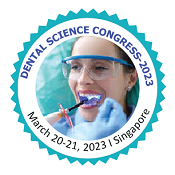
Arwa A AlSayed
MCD Private Practice, KSA
Title: Key Factors Affecting the Aesthetic Outcomes of Dental Implants in The Anterior Zone
Biography
Biography: Arwa A AlSayed
Abstract
The success of dental implant therapy is no longer judged by osseointegration only, esthetics has become an essential part of oral rehabilitation. Patients seeking implant treatment are not only expecting implant-supporting restoration to be functional long-erm, but also to be esthetic particularly in the anterior zone. For a long time, implant research was focused on the per-implant bone, establishing hard tissue quality and quantity as being the principal criteria for defining success. More recently, emerging evidence suggests that peri-implant soft tissues are key to maintaining peri-implant health, even in the case of missing buccal bone at implant sites.
Based on recent epidemiologic data, the prevention of peri-implant disease (peri-implant mucositis or peri-implantitis) has become a major task in daily practice. These data showed that 30% of all implants and 47% of all patients will experience peri-implant mucositis, and 10% of all implants and 20% of all patients will experience peri-implantitis. The risk factors that are directly or indirectly related to implant failure were identified as esthetic risk factors, timing of implant placement, timing of soft and hard tissue augmentation. The esthetic risk factors (gingival, dental, osseous, and implant factors, provisional restoration) are well reported to have big impact on the esthetic outcomes, in particular when patient selection for success criteria were not applied precisely. Moreover, the skills and the experience of the practitioner are well documented in the literature to have a significant impact on the functional and esthetic outcomes of implants in the esthetic zone.
It is now well documented that in order to avoid any post implant complications and insure patient satisfaction, a proper risk assessment and management of soft and hard tissues at the planned implant site is important prior to any implant-related surgery.

